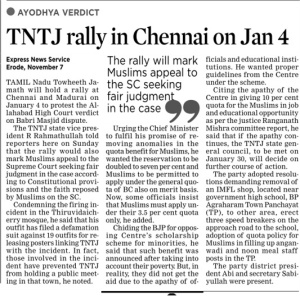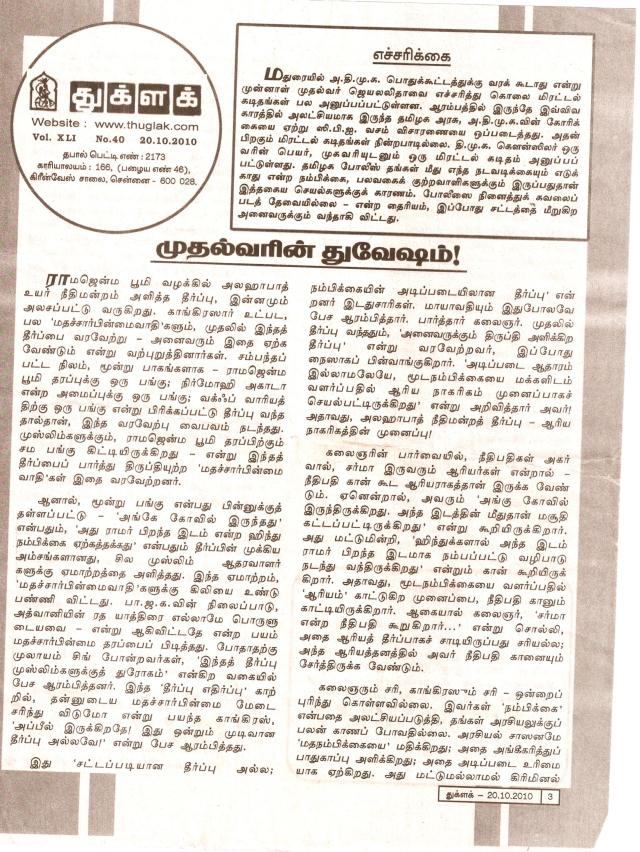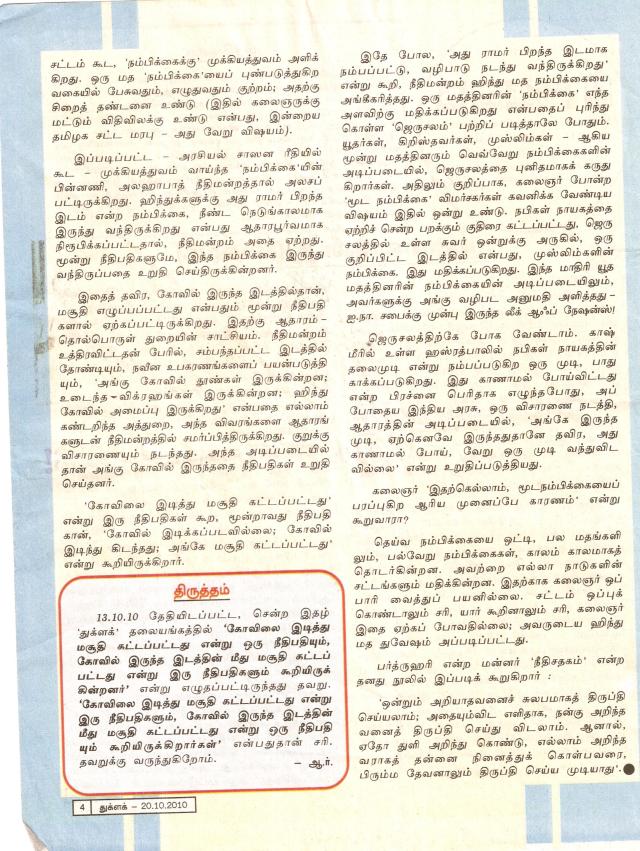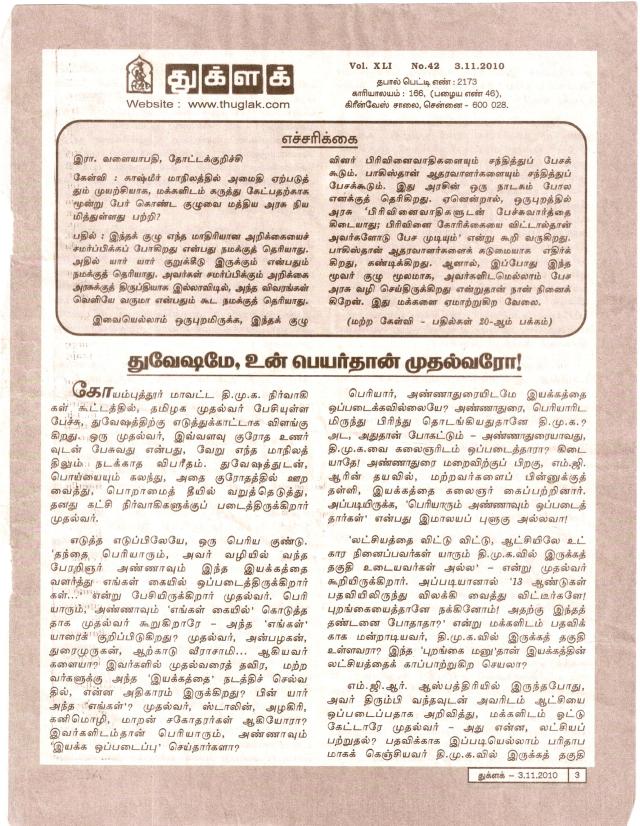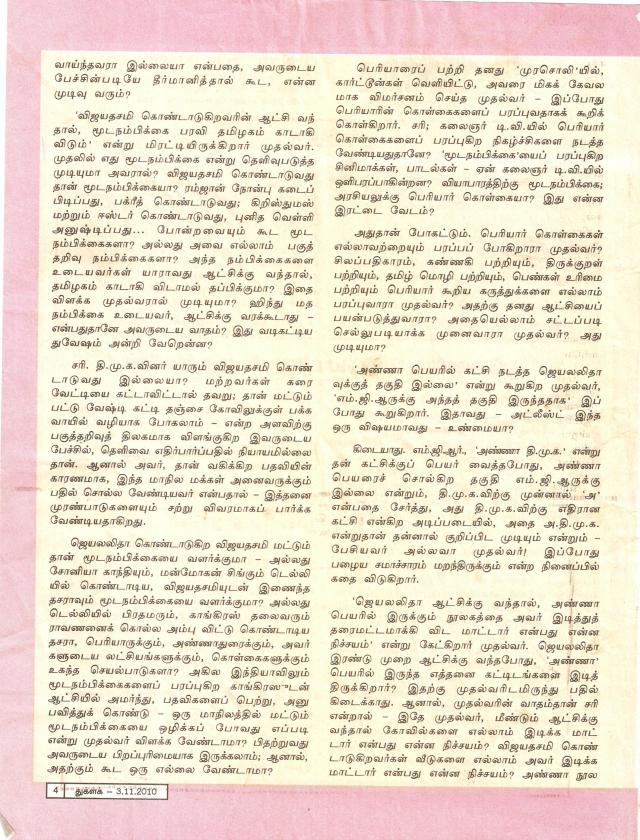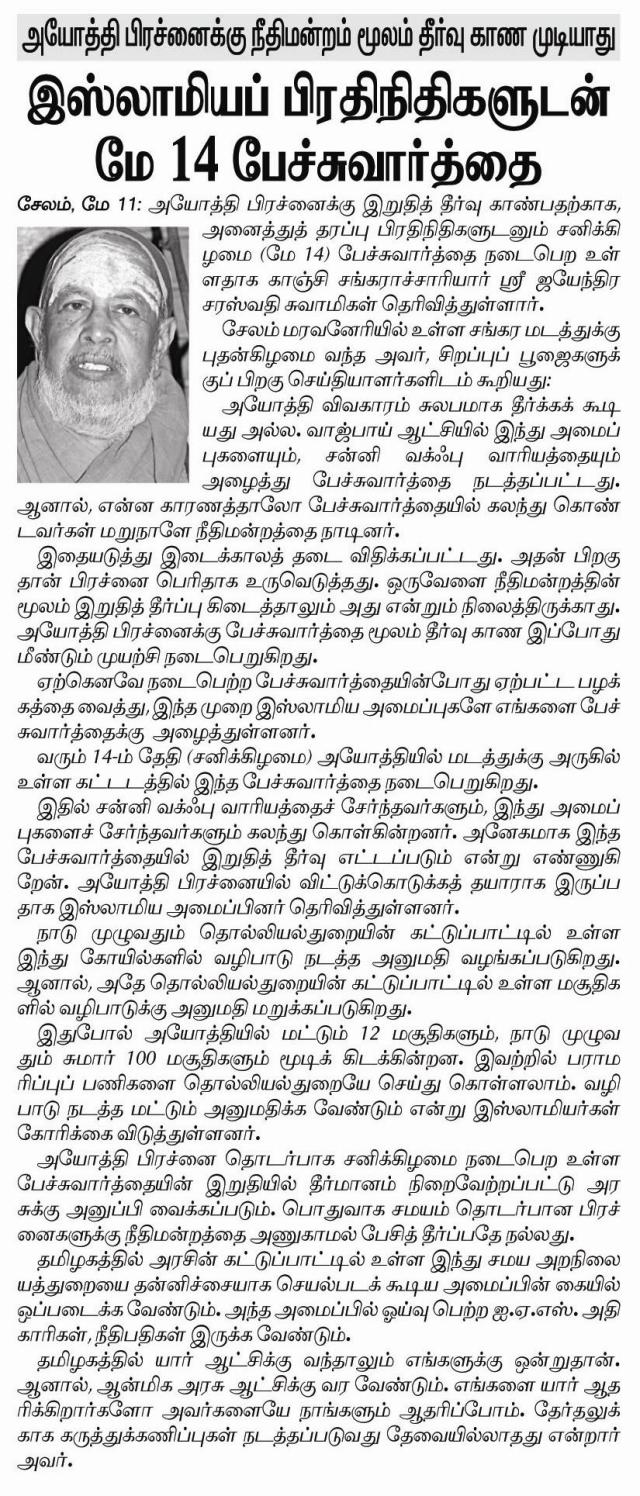சட்டத்தின்பார்வையில்ராமர் – டாக்டர்இரா.நாகசாமி –
டாக்டர்இரா.நாகசாமி[1]: எல்லாரும் எதிர்பார்த்திருந்த அயோத்தி வழக்கில், மூன்று நீதிபதிகள் தீர்ப்பு கூறிவிட்டனர். அத்தீர்ப்பில் இரண்டு முக்கிய முடிவுகள் வெளிவந்துள்ளன[2].
அவற்றில் முக்கிய முடிவு, பாபர் மசூதியின் கீழே ஒரு கோவிலின் இடிபாடுகள் உள்ளன என்பதை மூன்று நீதிபதிகளும் ஏற்றுக்கொண்டுள்ளனர்[3]. பாபர், அங்கிருந்த கோவிலை இடித்து விட்டு மசூதியைக் கட்டினாரா என்ற கேள்வியே அர்த்தமற்றதாகி விட்டது[4]. ஆதலின், அதைப் பற்றி யாரும் இப்போது கவலைப்படவில்லை. அந்த இடம் வழிபாட்டில் இருந்த இடம் என்பதால், இஸ்லாமியருக்கு மூன்றில் ஒரு பங்கும், நிர்மோகி அகாராவுக்கு ஒரு பங்கும், ராம் லாலாவுக்கு ஒரு பங்குமாக பிரித்துக் கொடுக்க நீதிபதிகள் தீர்ப்பளித்துள்ளனர். இதுகுறித்து பல கருத்துக்கள் எழுந்துள்ளன.
“இத்தீர்ப்பு சட்டப்படி அளிக்கப்பட்டதல்ல; ராமர் உயிருள்ள மனிதர் போல கருதும் நம்பிக்கைக்கு இடமளித்து, ராம் லாலாவுக்கு ஒரு பங்கு எனக் கொடுத்துள்ளது சட்டத்துக்கு ஏற்புடையது அல்ல. நம்பிக்கைக்கு முதலிடம் கொடுத்து அளித்தது. தெய்வம் என்ற நம்பிக்கையை மனிதர் போல் கொண்டு தீர்ப்பளித்துள்ளது நம் பண்பாட்டுக்கு ஏற்றதல்ல. ஆதலால், சட்டப்படி மேல் முறையீடு செய்து, இதை தோற்கடிக்க வேண்டும்’ என்பது வாதம். “தெய்வத்துக்கு நிலம்; பிற பொருள்கள் உரிமை கொள்ள முடியுமா?’ என்று பல வன்மையான கட்டுரைகள் வருகின்றன[5].
தஞ்சையில் மாபெரும் கோவிலை கட்டி, ஆயிரம் ஆண்டுகள் ஆனதை பெரும் விழாவாக இப்பொழுது தான் முடித்திருக்கிறோம். இவ்விழாவையும், இதைக் கட்டிய ராஜராஜனின் புகழையும் வரிந்து கட்டி எழுதாத பத்திரிகைகளே இல்லை. அவன் பண்பாட்டுக்கு செய்துள்ள மகத்தான பணியை வாழ்த்தாத வாயில்லை. ராஜராஜன் தான் தோற்றுவித்த தெய்வத்தை எவ்வாறு போற்றி வணங்கியிருக்கிறான் என்று இவ்வமயம் காணலாம். தன், தெய்வத்தை உயிருள்ள ஒரு பெருமகனை எவ்வாறு காண்பானோ அவ்வாறு தான் கண்டிருக்கிறான். அவன், தன் கோவிலில் எழுதியுள்ள கல்வெட்டுகள் அனைத்தும் சட்டப்படி பதிவான பத்திரங்கள் தான். அவன், தன் தெய்வத்துக்கு வழிபாட்டுக்கு, பிற செலவுகளுக்கும் ஏராளமான நிலங்களும், ஊர்களும் அளித்து அவற்றை துல்லியமாக எழுதி வைத்துள்ளான்.
அவற்றில் அவன், “இராஜராஜீச்வரம் உடைய பரமசுவாமிக்கு நாம் கொடுத்தது’ என்று தெளிவாக எழுதியுள்ளான். நிலம் கொடுத்தது மட்டுமல்ல, அணிகலன்கள் கொடுத்தது, சமையல் கலங்கள் கொடுத்தது என என்னென்ன கொடுத்தானோ, அத்தனையையும் தனித்தனியாக, “அவருக்கு கொடுத்தது’ என்றே எழுதியுள்ளார். அத்துடன், அந்த தெய்வத்தை, “உடையார்’ என்றும் தவறாது கூறுகிறான். அதாவது, நிலம், அணிகலன் என எல்லாவற்றையும் உடையவர் அவர் என்று கூறுகிறான். ராஜராஜன் பின்பற்றிய சட்டப்படி கோவிலில் உறையும் தெய்வம் உயிருள்ள மனிதர் போலவே கொள்ளப்பட்டுள்ளது என தெள்ளத் தெளிவாக குறித்துள்ளான்[6].
இது, ஆயிரம் ஆண்டு பண்பாடு. இது ஏதோ ராஜராஜன் தோற்றுவித்த மரபு அல்ல. அவனுக்கு முன்னர் பல நூற்றாண்டுகளுக்கு முன்பிருந்தே நிலவிய சட்ட மரபு தான்[7]. பல்லவர், பாண்டியர், சோழர் விட்டுச் சென்றுள்ள சட்டப்படி பதிவு செய்யப்பட்ட பத்திரங்கள் தான். அவை, அனைத்திலும் தெய்வத்தை மனிதர் போல் பொருள் கொள்ளும் தத்துவமாகத்தான் கருதப்பட்டுள்ளது. ராஜராஜனுக்குப் பின்னரும் இன்று வரை கோவில்களுக்கு கொடுக்கப்பட்ட கொடைகள் அனைத்தும் அந்தந்த தெய்வத்துக்கு கொடுக்கப்பட்டவை தான். பல்லாயிரம் கல்வெட்டுகள் உள்ளன.
வெள்ளைக்காரர்கள் காலத்திலும் கோவில் தெய்வம் பொருள் கொள்ள முடியுமா? என்ற வாதம், நீதிமன்றங்களில் வந்துள்ளன. வெள்ளைக்கார நீதிபதிகளும், சட்டத்தை ஆய்ந்து, தெய்வங்களுக்கு பொருள் கொள்ளும் உரிமை உள்ளது என்பதை பல வழக்குகளிலே நிரூபித்து தீர்ப்பு கூறியுள்ளனர். படாதாகூர், சோடாதாகூர் என்ற வழக்கு ஒரு நூறு ஆண்டுகளுக்கு முன்னர் நடைபெற்றுள்ளன. அவற்றில் எல்லாம் இந்த நிலை ஏற்றுக்கொள்ளப்பட்டுள்ளது. நம் நாட்டில் ஈராயிரம் ஆண்டுகளாக உள்ள பல்லாயிரக்கணக்கான கல்வெட்டுகளும், செப்பேடுகளும், வெள்ளைக்காரன் நீதியும் கூட இம்முடிவுக்கே வந்துள்ளன.
அலகாபாத் நீதிபதிகள் நீதி முறை தெரியாதவர் அல்ல. பல தீர்ப்புகளையும் ஆய்ந்து, சான்றுகளையும் அறிந்தோர். ஆதலின் அவற்றை ஆதாரமாகக் கொண்டு அளித்த தீர்ப்பு, சரியான, சட்டப்படி நேர்மையான தீர்ப்பே. வரலாறும், அண்மைக் கால தீர்ப்பும், அதையே காட்டுகின்றன. நம்பிக்கையின் பேரில் அளிக்கப்பட்ட தீர்ப்பல்ல. அந்நீதிபதிகள் வரலாற்று நோக்கிலும், சட்ட நோக்கிலும் நம் பாராட்டுக்கு உரியவர்கள்.ஆதலின், சட்டத்தின் பார்வையில், ராம் லாலாவுக்கு கொடுக்கப்பட்ட நிலம் சரியே.
– டாக்டர்இரா.நாகசாமி -
[1] டாக்டர் இரா.நாகசாமி – முந்தைய தமிழ்நாட்டு மாநில தொல்துறையின் இயக்குனர், தொல்துறை நிபுணர், சரித்திர ஆசிரியர். குறிப்பாக பத்தூர் நடராஜர் சிலை / விக்கிரகத்தை கடத்திச் சென்று, இங்கிலாந்தில் விற்றபோது, லண்டன் நீதிமன்றத்தில் ஆஜராகி, விக்கிரகத்தை அடையாளங்காட்டி மீட்டு வந்ததில் முக்கிய பங்கு வகித்தவர். அப்பொழுது லண்டன் நீதிமன்றத்தில், சிலை / விக்கிரகம், சட்டப்படி, ஒரு நபர்தான் ஆகவே, அவர், அவருடைய கோவிலுக்குச் சொந்தமானவர். ஆகவே, அவர் கோவிலுக்குத்தான் ஒப்படைக்க வேண்டும். அதாவது, கோவில் விக்கிரகத்திற்குச் சொந்தமானது, விக்கிரகம் கோவிலுக்குச் சொந்தமானது. அதுபோலத்தான், சட்டப்படி அயோத்தி நிலம் ராமருக்குச் சொந்தமானது, ராமருக்கு அயோத்தி நிலம் சொந்தமானது.
[2] தினமலர், சட்டத்தின்பார்வையில்ராமர் – டாக்டர்இரா.நாகசாமி, பதிவு செய்த நாள் : அக்டோபர் 10, 2010,23:49 IST; மாற்றம் செய்த நாள் : அக்டோபர் 12,2010,02:18 IST; http://www.dinamalar.com/News_Detail.asp?Id=103771
[3] முழு தீர்ப்பு படிக்கக் கிடைப்பதால், அதைப் படித்து மற்றவர்கள் கருத்து சொல்லவேண்டும். ஆனால், பலரும், படிக்காமலேயே, தீர்ப்பு பற்றி குறைகூறுவது சரியில்லை.
[4] அதாவது அந்த பிரச்சினை, ஆதாரங்களின் மீதுள்ள நிலையில், கோவில் உள்ளது என்பதனால், அந்த சர்ச்சையை வளர்க்க வேண்டிய அவசியம் இல்லை.
[5] சட்டப்படி விக்கிரகம் என்பது ஒரு நபர், அவருக்கு சொத்து முதலியவை உரிமையாக வைத்திருக்கலாம், சடங்குகள், விழாக்கள் நடத்தலாம்…….எல்லா உரிமைகளும் உண்டு. அந்த சட்ட உரிமைகளை மறுப்பதுதான், சட்டவிரோதமானது.
[6] முன்னர் குறிப்பிட்டப்படி, விக்கிரகம் ஒரு சட்டாப்பூர்வன்மான நபர், ஆகவே, அவர் சொத்தை வைத்துக் கொள்ளலாம், அனுபவிக்கலாம். மற்றவர்கள் அதை / அவற்றை கையாட நினைத்தால், கொள்ளையடித்தால், அவரது இருப்பிடத்தை / கோவிலை இடித்தால் வழக்குப் போடலாம், சட்டப்படி, திரும்ப தனது சொத்தைக் கேட்டுப் பெறாலாம்.
[7] சட்ட மரபு என்று அழகாக விளக்கியுள்ளார். ஏனெனில் சட்டமும் மனிதனால் ஒருவாக்கப்பட்டதே. காலங்காலமாக இருக்கும் சட்ட-சம்பிரதாயங்களை அனுசரித்தே சட்டங்கள் இயற்றப்படுகின்றன.


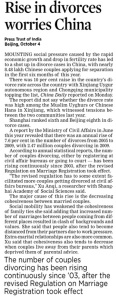
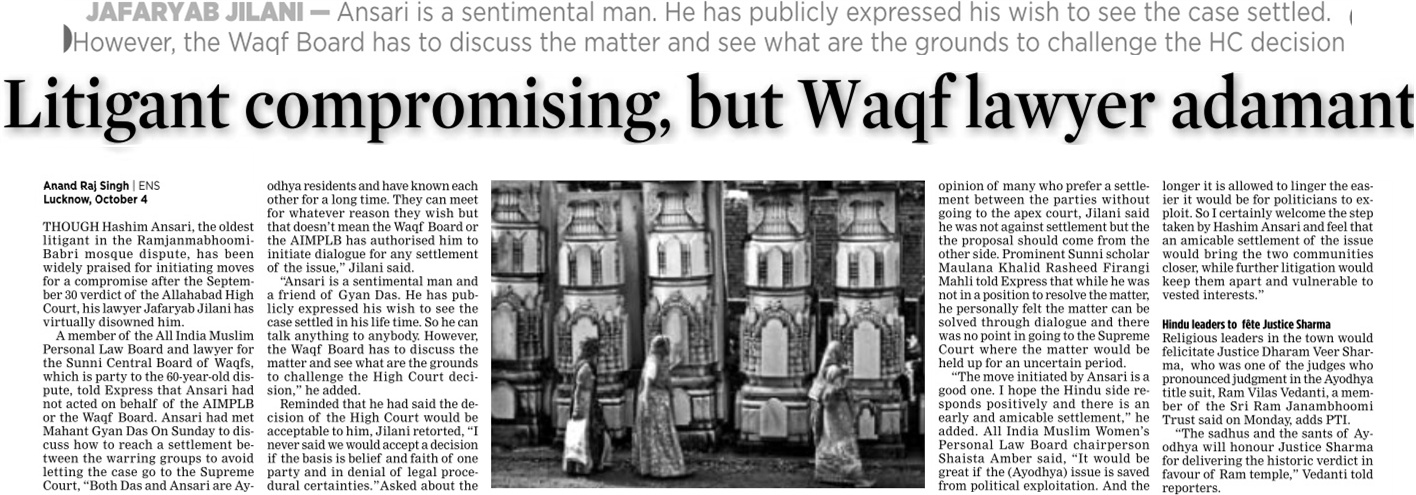


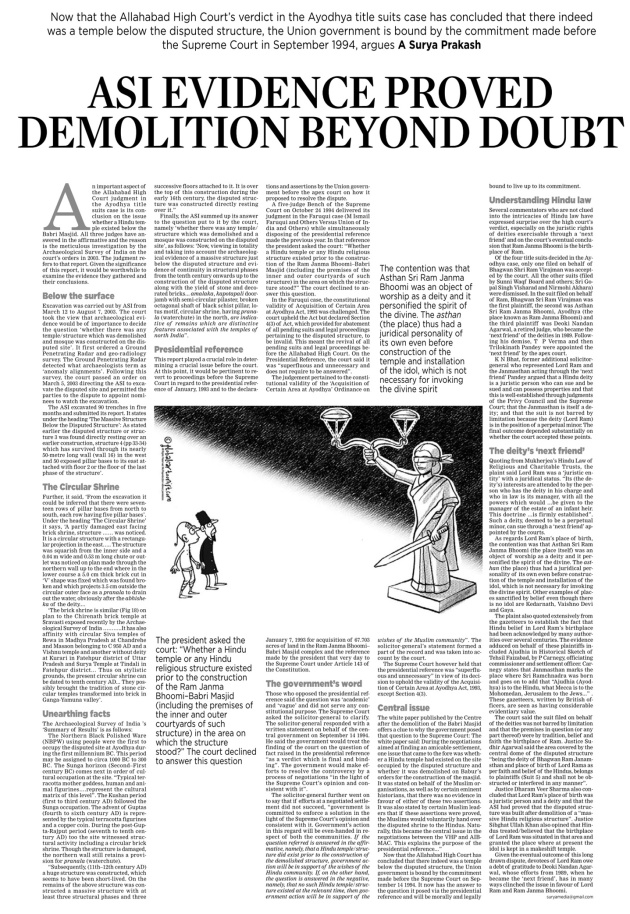

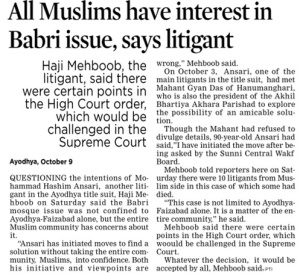

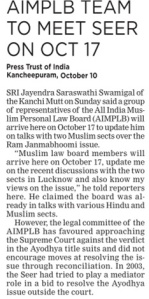
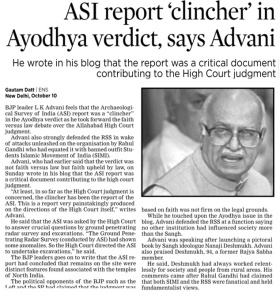

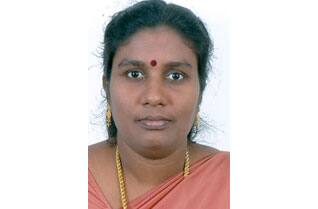 சென்னை : அயோத்தியில் ராமர் கோவில் கட்ட வேண்டும் என்பதை வலியுறுத்தி, விஸ்வ இந்து பரிஷத் சார்பில் நடத்தப்பட்ட கையெழுத்து இயக்கத்தில், பங்கு பெற்ற கன்னியாகுமரி தொகுதி எம்.பி.,யிடம் தி.மு.க., தலைமைக் கழகம் விளக்கம் கேட்டுள்ளது.
சென்னை : அயோத்தியில் ராமர் கோவில் கட்ட வேண்டும் என்பதை வலியுறுத்தி, விஸ்வ இந்து பரிஷத் சார்பில் நடத்தப்பட்ட கையெழுத்து இயக்கத்தில், பங்கு பெற்ற கன்னியாகுமரி தொகுதி எம்.பி.,யிடம் தி.மு.க., தலைமைக் கழகம் விளக்கம் கேட்டுள்ளது.